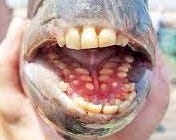
Eyeball to eyeball, they’re uglier than homemade soap.
Small mouth but big teeth and lots of ’em. More teeth than grandpa’s rip-saw, and not exactly in decent formation.
Sloped head with protruding eyeballs. Not a lot going on in the looks department.
You know the type.
In terms of the correlation between their highly lacking studio portrait and how much we love them anyway, the sheepshead stands (sloping) head and (broad) shoulders above most.
So if you wander into the fish market and see sheepshead on ice, come off the hip just a bit and do yourself a favor. It’s what we call a fish-eater’s fish.
And here’s the best part: You don’t need your wallet or even a boat to find them. In fact, you’ll often find boating anglers anchored or tied off around the pilings or fenders of a bridge, dropping their lines straight down. And this area has several public fishing piers with barnacle-housing pilings of their own, as well as a massive bridge footing within an easy cast.
“Fishing from a dock, drop your line straight down,” says Capt. Jeff Patterson (Pole Dancer charter). “One thing different about sheepshead, you can find them all throughout the water depth columns. I’ve seen as many as 50 at a time when the water is clear.”
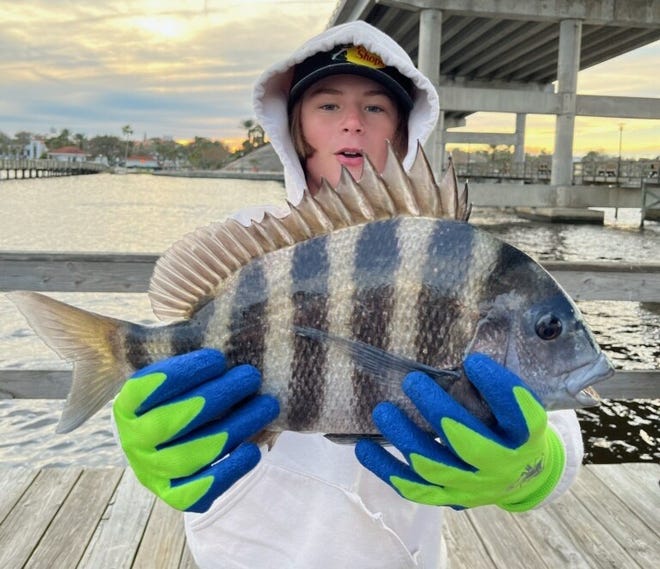
Palm Coast Capt. Mike Vickers says it won’t hurt to chum the water with some ground-up oysters or shrimp (or buy a box of chum from the bait shop). Many boating anglers accomplish this by bringing a shovel or hoe and scraping the pilings, releasing plenty of barnacles and hopefully turning on the sheepshead.
As for the gear needed, “everything I need, I can carry in my pocket,” Capt. Mike says.
“A No. 1 or 1/0 hook and a No. 1 or No. 2 split-shot,” he says.
Capt. Jeff prefers a No. 2 O’Shaughnessy hook and about 18 inches of 20-pound mono leader, though he also touts a 1/0 circle hook.
With sandfleas still AWOL, fiddler crabs are the best bait for sheepshead — “When you can get them,” says Capt. Jeff.
Otherwise, small shrimp are always good, while others swear by salted clam strips.
Once rigged up, “I fish my bait vertical and tight to structure,” says Capt. Mike.
Let your bait sink to the bottom — generally you want at least six feet of water depth — and slowly bring it up. If you’re shut out after several attempts, try the next nearest dock or bridge piling.
And if you get lucky, don’t ruin it by mishandling the fish and letting it introduce your thumb to its dental prowess.
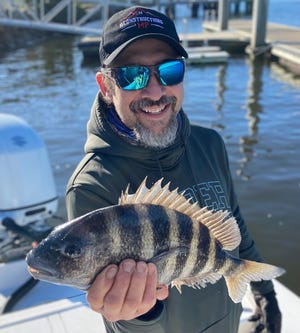
Halifax/Indian River
Bundle up over the next few days and get your gear organized and ready to roll, because by early next week we’re looking at a few days of warm temps and southern breezes. At minimum, we should return to much of what we saw this past week, which was a mixed bag.
The good mix: Sheepshead are there for the taking if you have the know-how (see above) and patience. Reminder: Minimum keeper size is 12 inches, daily bag limit is eight.
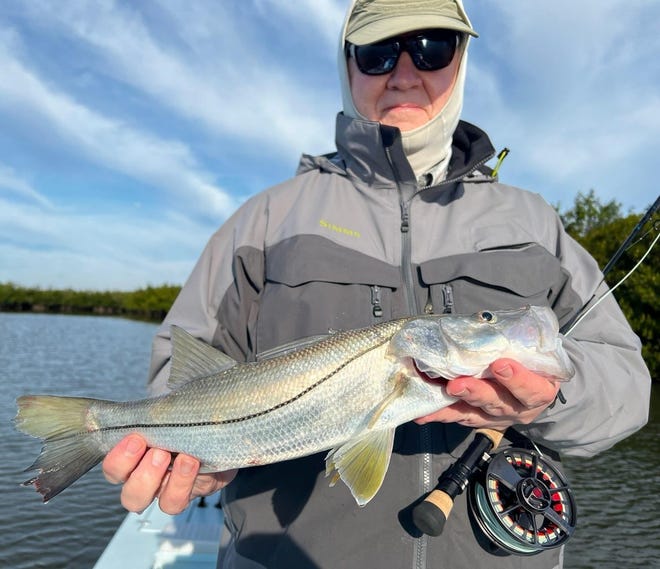
The mediocre mix: Bluefish are everywhere, it seems.
“The blues have taken over the inlet the last couple weeks with tons of smaller fish, 8 to 12 inches,” says Capt. Jeff Patterson. “Literally could not get past them the last few times I tried anywhere near the jetties.”
Blues are a fun catch but, for some, a hard sell as a meal. Many prefer them as an app, either smoked and picked apart, or folded into cream cheese and seasoning for a great dip. Quick, pass the Saltines!
Capt. Jeff says he’s also hooking up with seatrout around docks and inside creeks, and seeing “quite a few” of the trout’s cousin, the weakfish. No size or bag limits on the tasty weakfish, but you have to know the difference in the two fish’s spot patterns in order to make sure you’re not icing down the wrong one.
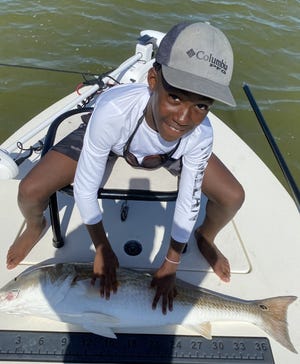
To the southern end of Volusia, Art Mowery says things have been a bit slow in the Oak Hill area. “A few trout and some small reds,” he says.
A bit north, fly-fisherman Geno Giza had a productive outing along the inshore waters of the Canaveral National Seashore, particularly the Turtle Mound area. About 1,500 casts (his estimate) with a buddy resulted in roughly 50 catch-and-release snook, trout and reds.
“I need to tie more Clouser minnows tonight,” a pooped Geno said.
Seems like a good time to remind everyone, snook remain catch-and-release through the end of January, and be extra careful next week after the cold passes. As was the case a week or two back, you’re likely to find belly-up snook in the mangroves of the backwaters. They, too, are off-limits.
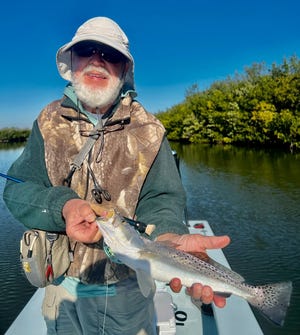
Heads up!
Capt. Charlie Beardsley, a staffer with the local Coast Guard Auxiliary, warns boaters to keep your eyes wide open when gunning it through the channels.
“I’m still seeing a good bit of debris floating around — partial docks and wood planks mainly,” he says.
Offshore
The Sea Spirit had to bag its weekend outings due to the front approaching, but got in a good trip midweek.
A wide mix of snapper was the biggest haul.
Surf
Remember the mention of bluefish throughout the inlet and into the intracoastal waters?
Well, that means it’s also a good time to have fun with them from the Atlantic shoreline.
Small mullet are most bluefishing folks’ live bait of choice, but the blues ain’t picky. You know the gold spoon that generally hides at the bottom of your Plano? Some surf anglers swear that thing is like catnip to blues.
Down in the National Seashore, around Apollo Beach, Dustin Smith (NSB Shark Hunters) says he had the rare but enjoyable get-together with a spinner shark this past week. Often confused with the blacktip, the spinner distinguishes itself after hookup by earning its name.
Hooking a spinner has been compared with trying to pick up a stray cat.
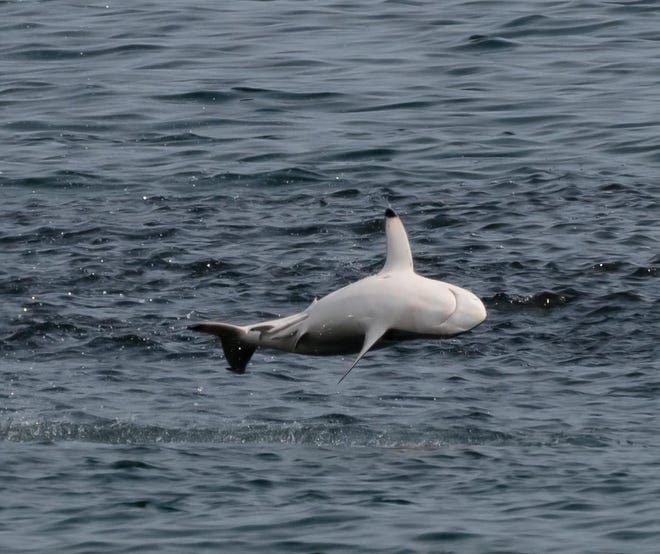
Flagler County
Capt. Mike Vickers (Hammock Beach Bait) is also seeing his share of bluefish.
“Swarming the area right now,” he says. “They’re mostly small, but they’re drawing a variety of sharks, so if you want the thrill of hooking one of these hard fighters, now is the time.”
Is he talking about the blues or the sharks? Yes!
The Matanzas Inlet area, Capt. Mike says, is the best place to find sheepshead and their cousin, the black drum.
St. Johns
In-and-out cold fronts have slowed the speck bite, but it’s expected to pick back up when things level off, says Capt. Bryn Adams from her family’s Highland Park Fish Camp in DeLand.
Bass fishing has been a different story.
“We’re seeing the bigger pre-spawn fish come in and have seen a lot over eight pounds, and have even seen a couple that were around 12 pounds,” she says.
Live shiners remains the fresh bait of choice.
Let’s Eat!
At the Halifax Sport Fishing Club, the first free seminar of 2023 will focus on the back end of this fishing deal.
“Chef Slavic,” of Down the Hatch fame, will teach you many of the basics of prepping and cooking that filet you brought home. For those who manage to catch their own, he’ll also give some useful tips on fileting that fish.
Oh, he’ll also pass out some samples of his grilling work.
It’s next Thursday (Jan. 19). Doors open at 6:30, brief club meeting at 7, seminar at 7:30.
More info: HSFC.com.
Hook, line and clicker: Send us your fish pics
We want to see your most recent catch. Email your fish photos to [email protected].
Please include first and last name of angler(s), as well as type of fish (we’re occasionally stumped). All are included with our online fishing report, and some occasionally make the print edition.
Do I need a fishing license?
You can find all the license info, including exemptions, on Florida’s Fish and Wildlife Commission website: MyFWC.com.
But the basics are: No: If you’re 65 or older, 15 or younger, you don’t need a license. No: If you’re fishing with a licensed guide or charter boat, both of which purchase commercial licenses that cover their customers. Yes: Most everyone else, including visitors from other states. Yes: Even if you’re a shore-based angler (shoreline, dock, pier, bridge, etc.). However: The shore-based license is free . . . But: You still need to register for that free license.
Where do I get a license and what does it cost?
Many bait shops sell licenses, as do the bigger retailers (Bass, Dick’s, Walmart, etc.). Florida’s FWC uses a third-party site for buying or renewing fishing licenses: GoOutdoorsFlorida.com. The cost: $17 for an annual license. Don’t forget: Whether you’re fishing fresh or saltwater, you need the specific license. Freshwater and saltwater licenses are both $17 annually.
I’m here on vacation, do I need a license?
Yes you do, and they’re also available at GoOutdoorsFlorida.com or certain bait shops and big retailers. Cost: $17 for three days, $30 for seven days, $47 for a year.Also: Non-residents need to purchase that license even if they’re just fishing from shoreline or shore-based structures. (Florida residents need that license, too, but they’re free.)
